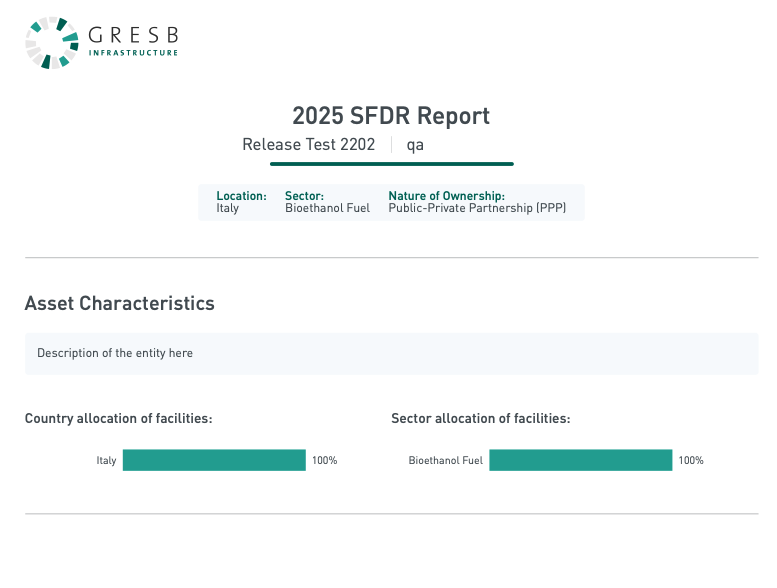SFDR targets financial market participants in the EU with a set of ESG disclosures aimed at providing transparency into the Principal Adverse Impacts (PAIs) of their investments.
The GRESB SFDR Reporting Solution
Since 2022, GRESB has provided the infrastructure and real estate sectors with an SFDR Reporting Solution designed to support annual PAI reporting. GRESB’s SFDR product enables participants to consolidate their product-level PAI disclosures and has also helped investors gather the relevant data across their real estate and infrastructure portfolios to inform their entity-level PAI disclosures.
Strong alignment between the GRESB Assessments and the SFDR disclosures across several core PAI indicators allows participants to use their GRESB data for SFDR reporting, thereby maximizing reporting synergies. This includes PAIs relating to GHG emissions, carbon footprint, energy, waste, and water.

Challenges with the SFDR’s labels
One of the most debated aspects of the SFDR is how its Article 8 and 9 designations are often used as de facto marketing labels for investment funds. This issue has been the crux of multiple consultations on the regulation, and this classification system is expected to be significantly revamped in the SFDR’s upcoming review.
These articles refer to a set of disclosure requirements for financial products that promote ESG characteristics (Article 8) and for financial products that have sustainable investments as their objective (Article 9). However, these classifications have often been repurposed as marketing labels to signify the level of sustainability of investment products—which was not the intention behind these articles and cannot be suitably facilitated through their design.
Combined with limited guidance and unclear criteria, this ambiguous differentiation and inconsistent interpretation by fund managers has resulted in accusations of greenwashing and concerns that investors may be misled about the true sustainability of an investment. In turn, this ambiguity has often made it difficult for investors to compare funds based on their sustainability performance, and the inconsistent applicability of the labels can make it difficult to clearly identify sustainable financial products for targeted investments.
The SFDR’s comparability challenge reinforces the complementary value of the GRESB Assessment in clearly and consistently differentiating best performing funds through its process of benchmarking, ranking, and scoring. GRESB provides a standardized universal language to assess the sustainability characteristics of a financial product and equips investors with the tools to clearly compare, identify, and track sustainability performance through an industry-tailored lens of high-quality and validated asset-level data.
Challenges with the SFDR’s real estate indicators
The SFDR has posed specific challenges for the real estate industry due to a variety of incompatibilities between the framing of the regulation and the realities of this asset class. This includes challenges associated with reporting to the real estate-specific PAI indicators and the difficulty of classifying real estate funds as sustainable under Article 9. Namely, the real estate PAI indicators have been criticized for being too complex and not easily harmonized across the EU, whilst Article 9 classification is deemed incompatible with most real estate funds due to the requirement that 100% of assets meet sustainable investment criteria.
Although the SFDR establishes an important regulatory baseline, these structural challenges make it difficult for investors to clearly assess the sustainability of real estate funds through the lens of the SFDR as the regulation was not designed to clearly reflect the characteristics of this industry. This is especially important given that real estate is a unique asset class that generates significant sustainability impacts spanning energy consumption, water usage, waste generation, and a variety of additional elements that are best understood with reference to aspects such as location and property type, amongst other factors.
These challenges reinforce GRESB’s unique value of being tailored to the needs and characteristics of the real estate industry, with the GRESB Standards reflecting the most materially relevant information for real estate investors. Accordingly, the GRESB Assessments represent a specialized framework calibrated to the realities of this asset class, thereby providing customized output that is designed to empower investors with actionable insights that are drawn directly from asset-level data. In the absence of an SFDR framework that is purposefully crafted for real assets, the GRESB Assessment provides valuable analytics for both managers and investors alike.
